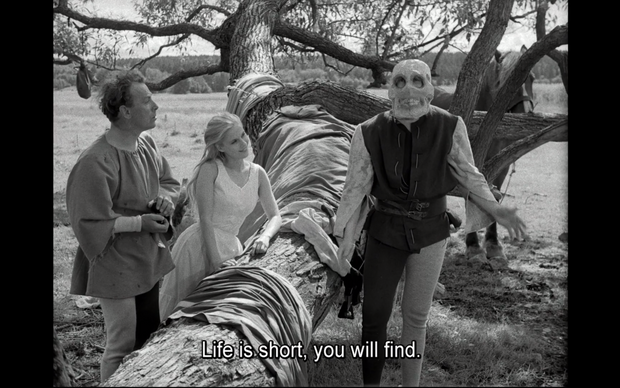Cinematography:
The entire movie was filmed within 35 days with the small budget of $150000, mostly under natural daylight or studio for indoor scenes. Considering how difficult it is to control outdoor lightings for shootings even for heavily budgeted production nowadays, it’s impressive how well they executed the cinematography with such limitation back in the 1950s. As an extremely philosophically sophisticated film, the cinematography did a fantastic job at supporting the concepts and enhancing the atmosphere.
Realism vs Drama:
As a realistic film, the B&W cinematography throughout the entire movie is faded, soft and atmospherically gloomy, the shots are mainly statically distant as a more objective overview. However, more close-up shots with dramatic sharp lightings are widely used during death’s appearances to create a relatively personal and surreal subjective experience, you can barely see pitch black during the film when death isn’t around.
For instance, the opening scene of this film shows long shots of Antonius and Jöns resting on the shore by the crashing waves under a cloudy sky, while voice of death narrating the first bits of The Seventh Seal from the revelation verses in the bible. The scene was gloomy yet bright enough for a peaceful contrast. As the water reflects the sunlight to cinematically pale grey, the horses and Antonius stood out in the water with their darker appearance that was also clear enough in front of silhouettes of rocks, it created a calm and quiet atmosphere that instantly captured my attention. Using the last supper scene as a comparison, multiple medium close-up or mid shots shows how the lighting on all character’s faces in the scene are angled, bright and sharp like professional spotlights on stage, companied by Antonius’ wife’s gentle voice peacefully reading the revelation verses, it’s like their preparation to accept and transition into the surreal idea of death.
The church confession scene is also a good example where multiple angled spotlights are used to created depth and clear contrast. In close-ups, death’s face behind the grid was bright white in contrast to his pitch-black cape, which the outline was clarified by another light source on the wall behind him that was ironically also spotlighting on Jesus on the cross statue. Antonius’s side was mostly pitch black besides the bright light coming through the grids and it solid black shadow falls on Antonius’s blonde shining hair on his left, whilst a soft light slightly brightens the right side of his head. The notion of confessing to death is realistically ridiculous and it was emphasized through dramatic lighting in this scene.
Visualizing Hope:
As lightness often represents hope and darkness as despair, the sense of purity, simplicity, happiness and hope in the acrobat family is precisely visualized through brightness. The family always appear in bright sunny outdoor space, performed in white makeup and dressed pale, while other parts of the movie are in gloomy darker grey. Besides any acrobat family appearances, you can barely find bright dominate white in the dark-grey-dominated cinematography of the entire movie.
Zone system:
Below is a graph I’ve created referencing the photographic zone system to further demonstrate my reasoning. Developed by Ansel Adams and Fred Archer, the zone system is a tonal scale from 0 being the darkest to 10 being the brightest widely used to dictate exposure in photography and cinematography. Extracting four dominate tones from frames with family’s appearances (top three), a regular scene (bottom middle) and scenes with Death’s involvement (bottom left and right), it is clear that family scenes are relatively brighter from 9-10 brightest to 1-3 darkest whilst other scenes could go as dim as 0 darkest to 8-9 brightest.










